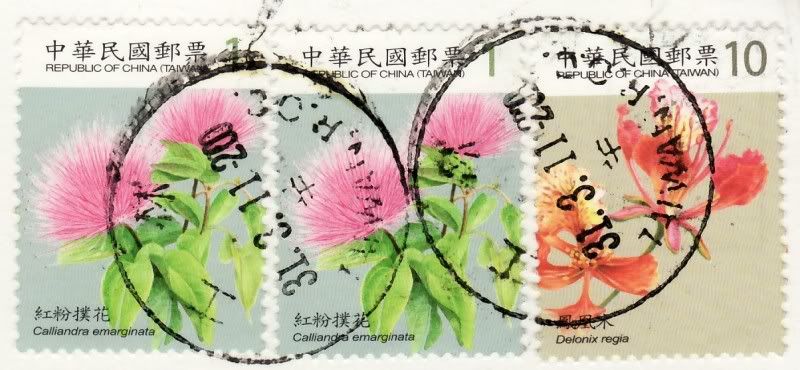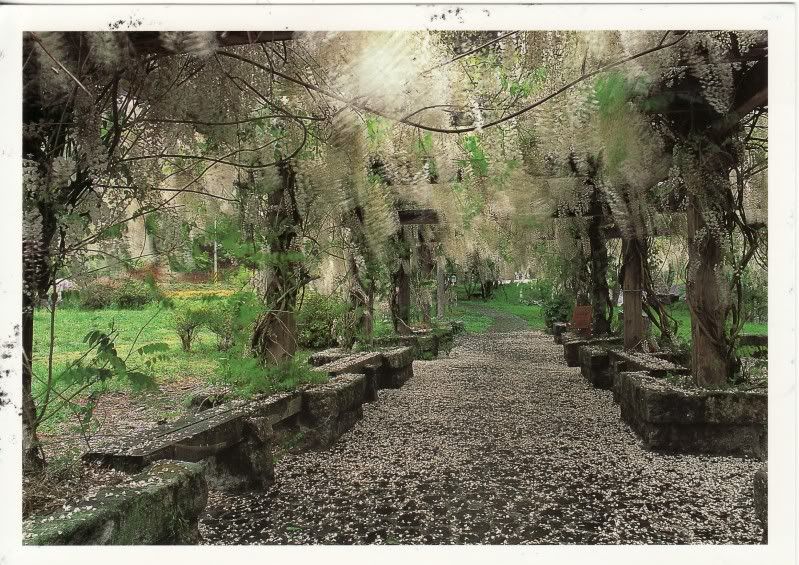It's a very unusual and beautiful postcard.
Wisteria sinensis (Chinese Wisteria) is a woody, deciduous, perennial climbing vine in the genus Wisteria, native to China in the provinces of Guangxi, Guizhou, Hebei, Henan, Hubei, Shaanxi, and Yunnan. While this plant is a climbing vine, it can be trained into a tree-like shape, usually with a wavy trunk and a flattened top.
It can grow 20-30 m long over supporting trees by counter-clockwise-twining stems. The flowers are white, violet, or blue, produced on 15-20 cm racemes in spring, usually reaching their peak in mid-May. The flowers on each raceme open simultaneously before the foliage has expanded, and have a distinctive fragrance similar to that of grapes. The fruit is a flattened, brown, velvety, bean-like pod 5-10 cm long with thick disk-like seeds around 1 cm in diameter spaced evenly inside; they mature in summer and crack and twist open to release the seeds; the empty pods often persist until winter. One very interesting fact about this plant is that it is actually a member of the pea family, and the abovementioned seedpods are actually legumes.
 All parts of the plant contain a glycoside called wisterin which is toxic if ingested and may cause nausea, vomiting, stomach pains, and diarrhea. Wisterias have caused poisoning in children of many countries, producing mild to severe gastroenteritis.
All parts of the plant contain a glycoside called wisterin which is toxic if ingested and may cause nausea, vomiting, stomach pains, and diarrhea. Wisterias have caused poisoning in children of many countries, producing mild to severe gastroenteritis.
It was introduced from China to Europe and North America in 1816 and has secured a place as one of the most popular flowering vines for home gardens due to its flowering habit. It has however become an invasive species in some areas of the eastern United States where the climate closely matches that of China.
Wisteria sinensis (Chinese Wisteria) is a woody, deciduous, perennial climbing vine in the genus Wisteria, native to China in the provinces of Guangxi, Guizhou, Hebei, Henan, Hubei, Shaanxi, and Yunnan. While this plant is a climbing vine, it can be trained into a tree-like shape, usually with a wavy trunk and a flattened top.
It can grow 20-30 m long over supporting trees by counter-clockwise-twining stems. The flowers are white, violet, or blue, produced on 15-20 cm racemes in spring, usually reaching their peak in mid-May. The flowers on each raceme open simultaneously before the foliage has expanded, and have a distinctive fragrance similar to that of grapes. The fruit is a flattened, brown, velvety, bean-like pod 5-10 cm long with thick disk-like seeds around 1 cm in diameter spaced evenly inside; they mature in summer and crack and twist open to release the seeds; the empty pods often persist until winter. One very interesting fact about this plant is that it is actually a member of the pea family, and the abovementioned seedpods are actually legumes.
 All parts of the plant contain a glycoside called wisterin which is toxic if ingested and may cause nausea, vomiting, stomach pains, and diarrhea. Wisterias have caused poisoning in children of many countries, producing mild to severe gastroenteritis.
All parts of the plant contain a glycoside called wisterin which is toxic if ingested and may cause nausea, vomiting, stomach pains, and diarrhea. Wisterias have caused poisoning in children of many countries, producing mild to severe gastroenteritis.It was introduced from China to Europe and North America in 1816 and has secured a place as one of the most popular flowering vines for home gardens due to its flowering habit. It has however become an invasive species in some areas of the eastern United States where the climate closely matches that of China.

No comments:
Post a Comment